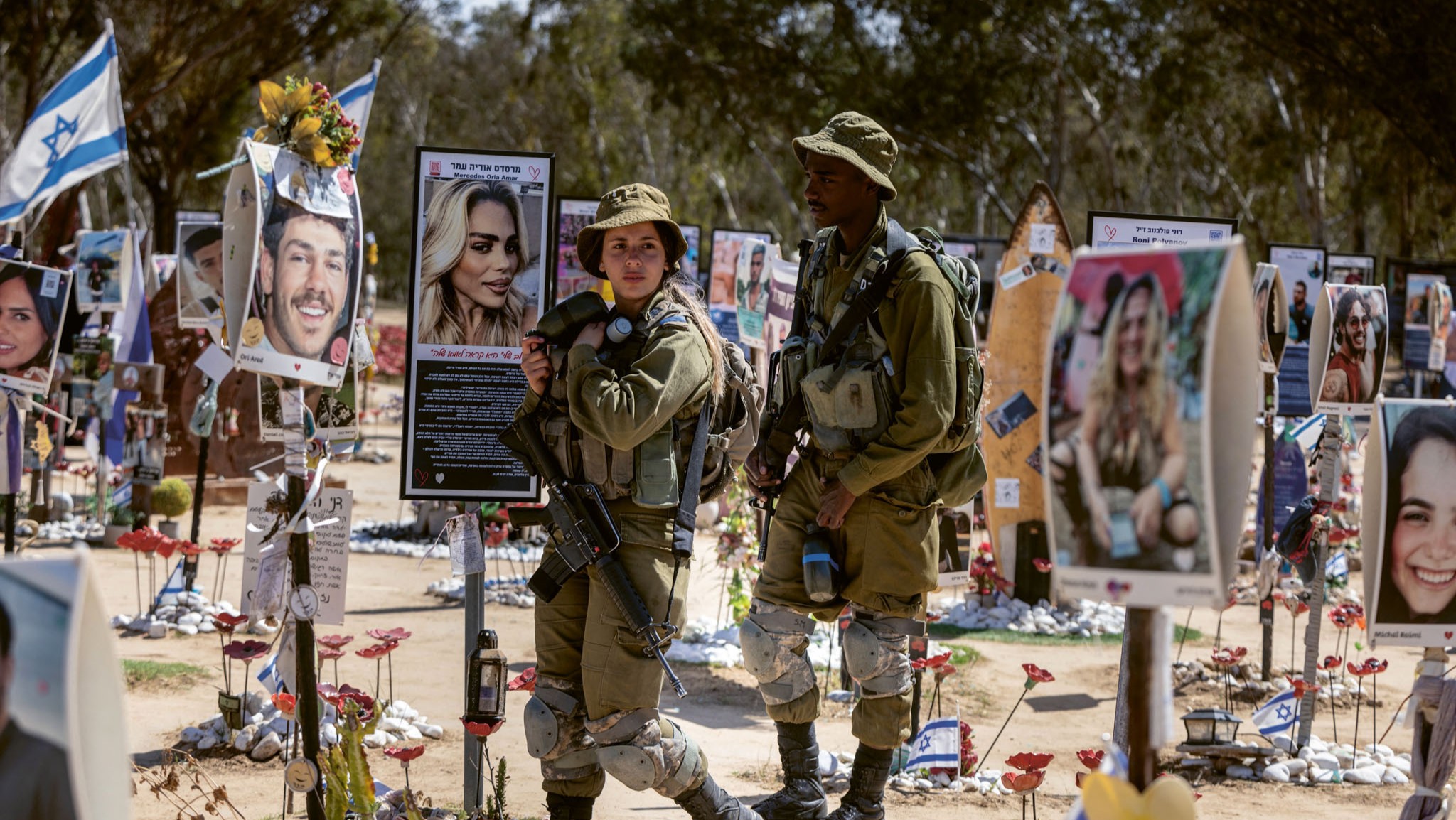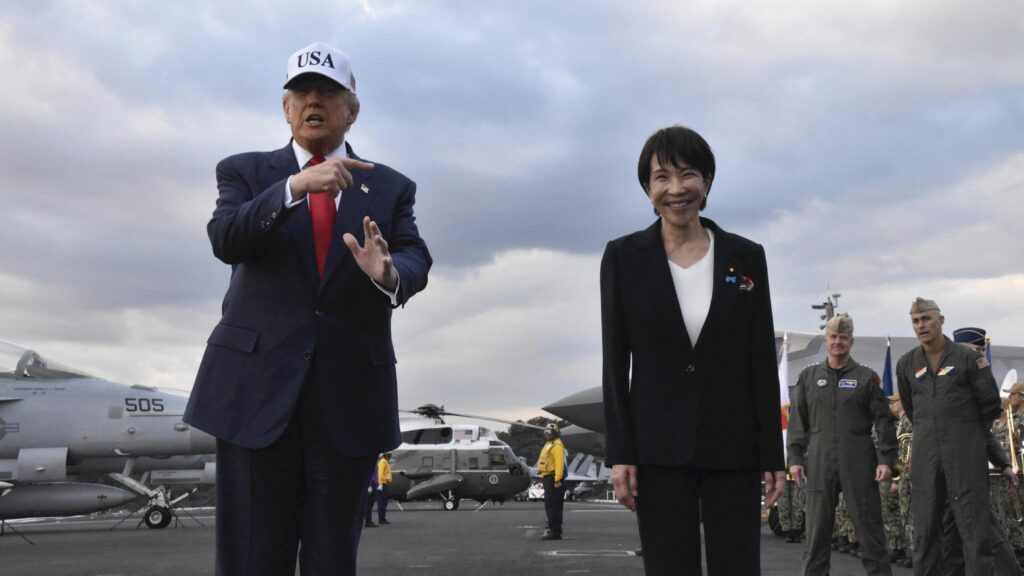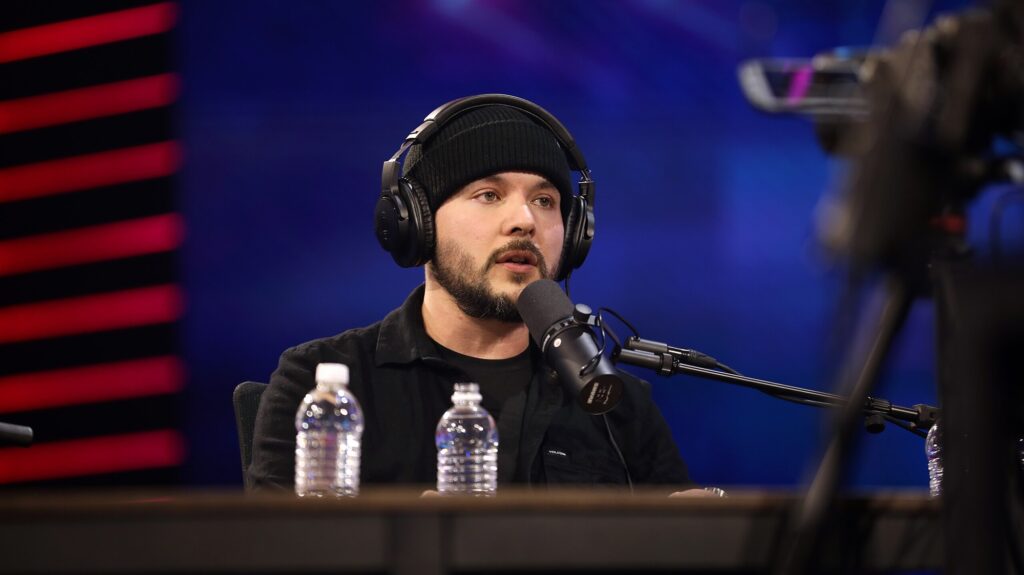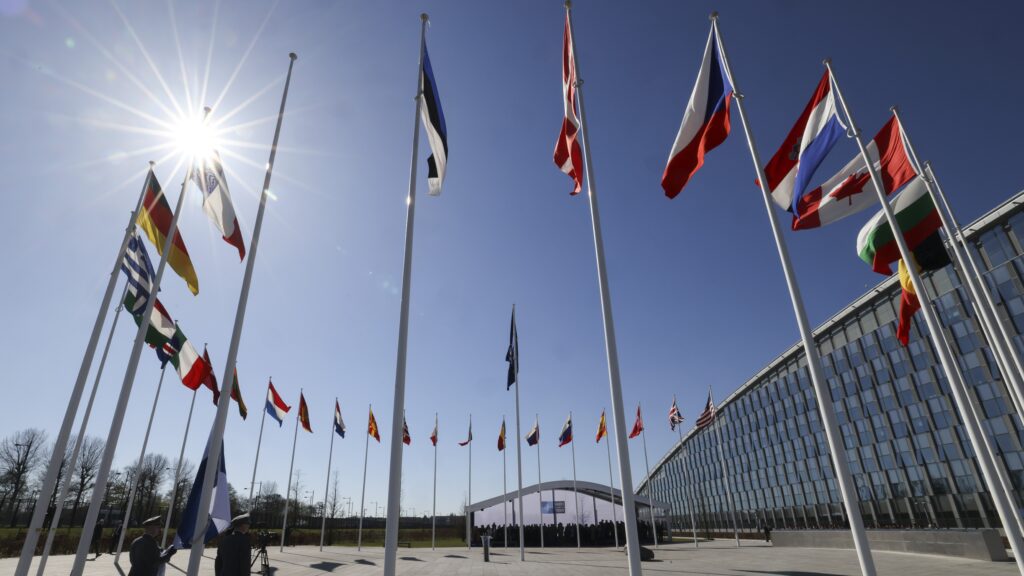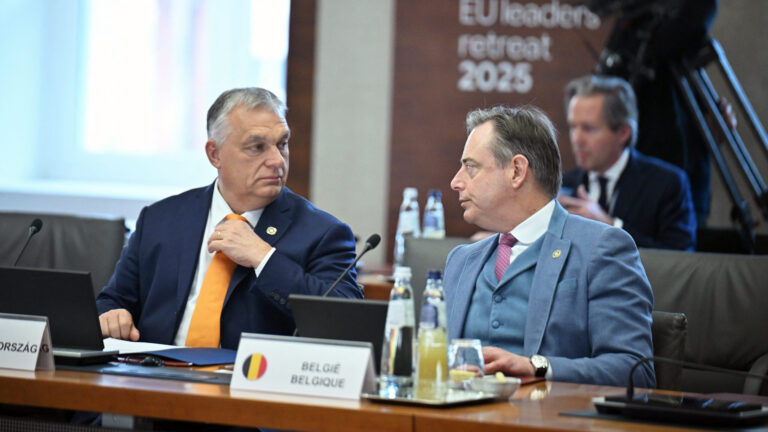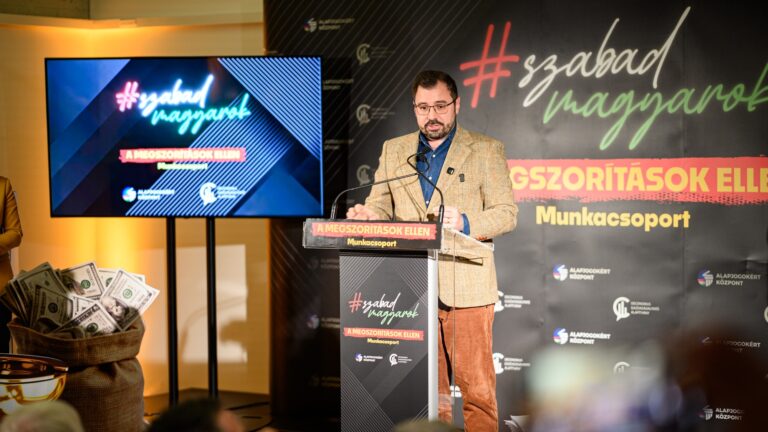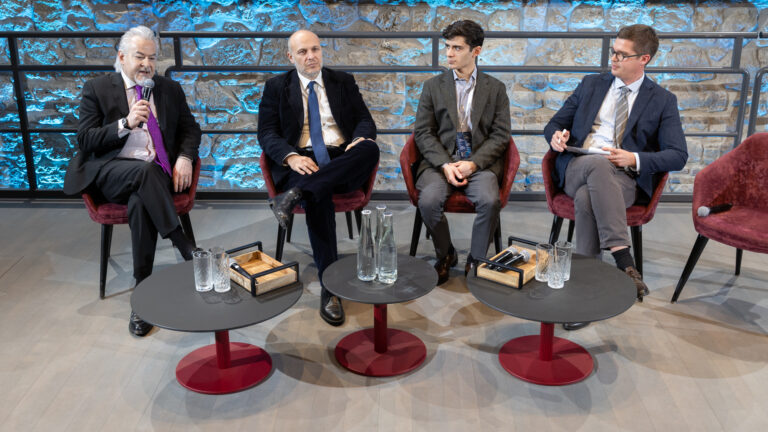This article was originally published in Vol. 5 No. 3 of our print edition.
As the Jewish State Mutates in Profound but Poorly Understood Ways, Even Its Supporters Would Do Well to Visit
Nearing Ben-Gurion Airport in mid-February this year, clouds of foreboding slid east with us from Israel’s bordering terror strip to cast a shadow over the whole land. Our smooth return hinged, admittedly, on a nerve-wracking first phase of the civilians-for-terrorists swap, and the spectre of resumed hostilities hung over our weeklong tour. Three hostages were eventually delivered across the Gaza fence by the Red Cross,1 as—five days later—were the Bibas family’s corpses,2 paraded by crowds of jubilant ‘civilians’. We flew with unexpected ease into and out of a war-stricken nation, shrouding trauma beneath a veneer of hospitality. The hostages, for their part, came out gaunt and emaciated—or dead.
They were made to hold ‘certificates of release’, or their coffins read they had been ‘detained’ on 7 October. Their 15 months of torment ended with a pang of on-camera anguish, as masked figures in green bandanas instructed them to convey the mortal menace they had just survived. The scar left by their captivity is only gradually being revealed.
Venturing toward Gaza, we paid our respects to the ‘world’s bomb shelter capital’, habitually a frontline bastion of Jewish strength beneath rocket-strewn skies, to which residents returned only six months after the attack. Hamas kept the city of Sderot under siege for three days after its invasion,3 massacring a busload of Russian-born retirees locked out of an air raid shelter.4 We converged on what felt like a rolling national pilgrimage to improvised grieving sites turned into national mausoleums. The parking lot at Kibbutz Re’im, near the Nova festival grounds, had by then surpassed the Kotel as Israel’s busiest site, with over 200,000 monthly visits. Still suffering from PTSD after saving over 700 lives on 7 October, farmer-hero Rami Davidian5 timidly squeezed into our circle of chairs at the solemn memorial before shuttling back to therapy. He held back tears as he recounted his 48-hour rescue mission, still haunted by the souls he could not save that day.
The nearby ‘car wall’, meanwhile, captures more than the day’s vehicular casualties among Israelis who braved Sabbath to flee, rescue, or confront the enemy from behind the wheel.6 Amidst piles of burnt and charred bodywork, visitors are greeted by a calcinated ambulance in which eight passengers were blown up by an anti-tank missile. Zaka,7 the forensic volunteer unit doubling as a religious burial society for maimed victims, could not reassemble the body parts it found, meaning corpses could not be returned to the earth intact, in keeping with the belief in resurrection. Bereavement for Orthodox families of victims was thus turned into metaphysical anguish, a torment deliberately inflicted by an enemy religion. For many Israelis, both religious and not, the fact that the moshav or village of Tkuma8—a famously observant religious kibbutz—largely survived 7 October speaks of Godly protection. It also gives hope, as its Hebrew name means ‘resurrection’.
Yet with the exception of these harrowing visits, Israel worked its spell on us unmediated by trauma. Standing where festivalgoers had whirled dizzyingly, the fog of emotion felt suddenly pierced, to disarmingly reassuring effect. The same martial nerve was tangible at Bnei David,9 a religious pre-draft academy in Samaria where students base their service in the Torah’s commandments, and at a barbecue on the Gaza envelope, where our group circle-danced a hora to a DJ set with stationed reservists, minutes from the Nahal Oz base obliterated on 7 October. The sense of isolated impotence so crushingly familiar to Israel’s backers overseas suddenly felt sublimated into a rugged sobriety, with Israeli real-life ‘resilience’ feeling more substantial than the hackneyed phrase conveys.
Israel’s spell was cast, in fact, mostly without reference to the dead-end concept of Palestinian statehood. Only the raiding of an East Jerusalem bookstore10 midway through our stay recalled it—Western media downplayed the Hamas pamphlets it sold, which were confiscated—along with a checkpoint-paced detour into Bethlehem, ravaged and cleansed of Christians under Palestinian ‘autonomy’. With Christ’s birthplace teeming with street vendors spouting anti-Western slogans, Israel’s disengagement from the area in the 1990s struck us as a mistake no less evident than the 2005 pullout from Gaza. The kind of Palestinian state heedlessly lobbied for in the name of ‘self-determination’ suddenly seemed a quixotic liberal distortion.
‘The kind of Palestinian state heedlessly lobbied for in the name of “self- determination” suddenly seemed a quixotic liberal distortion’
Another succinct rebuttal to the two-state ‘solution’ came from Mordechai Kadar,11 a Middle East scholar who pitched to us a web of Palestinian emirates in the West Bank and Gaza, with authority entrusted to the local chieftains that were deposed by an embittered Palestinian nationalism in its state-to-be. In a region beset by state failure, Kadar highlighted the relative success of such statelets in the Persian Gulf, where tribal and ancestral forms of leadership, he argued, proved a better fit for the anthropological baseline they rule over. The alternative of modern nation states had spread to the region’s detriment, he lamented, seeking to cohere Christian, Druze, Bedouin—and historically, Jewish—minorities as peripheral to the Sunni masses that suddenly felt encircled by interlopers. Even where power was handed to elite, non-Sunni families, such as Syria’s Alaouites, the Ba’athist playbook was everywhere to attempt to maintain cohesion against the unifying scapegoat of Zionism. And when it gives way to Islamist parties or militias blending fanaticism with calls to root out corruption and boost opportunity—with the outbreak of the Arab Spring, or now at the end of Syria’s war—there is a risk that full-blown religious caliphates might be formed.
When I asked which Israel fears less—secular Ba’athism, corrupt and inefficient, or a religious party more responsive to popular yearnings—Kadar affirmed that the Jewish state assesses risk case-by-case, and that neither was more hostile per se. Up on the Golan Heights overlooking Syria, where Vice-Governor Yaakov Selavan recounted to us the evacuations decreed under rocket fire from nearby Lebanon, I glimpsed the truth in Kadar’s response. As if to allegorize the inscrutable motives of the postbellum regime in Damascus, Syria’s capital appeared clouded by fog that day. Though the strictly anti-colonial terms in which Arab armies invaded in 1967 and 1973 appear remote, the new regime is not (yet) aligned with the ongoing four-front Islamic crusade on Israel. Yet it is not afforded the benefit of the doubt either. Syria’s ten-year civil war unfolded with manageable risk for Jerusalem, but even before it ended, Israel seized the security-enhancing opportunity to pierce deeper into Syrian territory. As the new regime consolidates with Western help despite unspeakable atrocities against Christians and Alaouites, fears mount that it may join the Iran-led axis, rekindling its hopes of reconquering the entire Golan. If its new leader’s nom de guerre—al-Jolani—is anything to go by, we were told, it should be taken as a declaration of intent (the al-Sharaas were indeed chased from the heights in 1967, thus the Golani demonym). Israel’s move optimized its war-readiness, not least from Mount Hermon, which it seized when Assad fled to Moscow, while it sent planes to target Syrian military capabilities. Looking down from our hilltop viewpoint, the overrun UN buffer zone seemed another casualty of the same paradigm shift, with worn-out pieties giving way to preventive self-defence.
Kadar’s tour d’horizon recalled a crude, contentious 2020 New York Times blog post by Thomas Friedman, likening the Middle East to an animal kingdom,12 but the anthropological basis for his deconstruction of the Arab nation-state merits reflection. Drawing from it, our host Yoram Hazony spoke of creating autonomous military zones for non-Muslim minorities across the region, rather than feigning surprise when bloodbaths and massacres occur. Both cases seemed to echo and extend Arab nationalist grievances against Europe’s colonial imposition of arbitrary borders, housing disparate, mosaic-like polities. Kadar’s model would prevent that mistake from being repeated, while offering Israel a credible partner for peace in these Dubai-modelled emirates, and bypassing the common gripe of a future Palestinian state being doomed to territorial discontinuity amidst post-1967 Israeli settlements dotting the West Bank. By dismembering the vehicle for anti-Zionist terror that a Palestinian nation state would inevitably become, it would even (and Arab Israelis are key to this hope) ensure better ties with newly implanted Jewish communities across it, which every Palestinian leader has vowed to uproot and deport—or worse.
Throughout the trip, indeed, various gentile Israeli voices inveighed against the fanaticism of their Palestinian cousins. These included Bethlehem’s lone evangelical pastor, a target of Hamas threats, or Bassam Eid,13 whose NGO rails against the torrent of EU—and formerly USAID—money lining the pockets of pro-Hamas shills on the ground. Others outright embraced an Israeli nationalism that foregrounds the Jewish state’s protective role towards minorities, whether Arab, Bedouin, or Druze. Elias Zarina’s Jerusalemite Initiative,14 for instance, is nothing short of a call to arms for his fellow Israeli Arabs, encouraging them to fulfil their civic duty towards their state by volunteering for the army. On the back of a successful business career, Shadi Khaloul,15 the first gentile to command an Israel Defense Forces (IDF) paratrooper unit before running for the Knesset, successfully lobbied Israel to officially designate his community of Arameans in the Galilee as autochthonous. He prayed an Our Father to us in Christ’s mother tongue, spoken in its modern variety by several thousand Israelis. The frequent charges of apartheid, ethno-nationalism, and settler colonialism levelled by accredited academics in the West seemed even more absurd than before.
The timing of our tour felt right, too, given the resumption of travel enabled by the truce. Lawfare, arrest warrants, and the siege of agitprop provided a stirring backdrop for Israel’s appeal to its dwindling band of true friends. As a rousing address delivered in the first-person plural from a sort of cultural Massada, the Jewish people’s sole authorship of their own post-war future was made more starkly human.
The fact that our delegation predominantly hailed from the USA was propitious, as the MAGA recoil from foreign quagmires gradually replaces the kinships—whether theological or sentimental—that underpinned for an earlier generation ‘America’s closest alliance’ with Israel. Our hosts decried a lingering liberal grip on non-state diplomacy, as speakers caveated their defence of Israel with side jabs against the country’s judicial reform or presence in the West Bank. What bearing tours like ours may have on Israel’s global image seemed a battleground for competing camps to frame the set of curated realities on display to guests. Queries about still substantial US aid deliveries to the IDF—‘what’s in it for us?’—were fielded to and articulately answered by our hosts, who largely derived from the country’s so-called ‘national-religious’ bloc, a decisive constituency in fighting the war. Both Americans and Israelis converged on an idiom, in tune with the evolving world order, that decouples values and interests, sentimental appeals and hard strategic truths. Former brigadier general (and now politician) Effi Eitam16 appealed in a quainter style for the United States to stay true to its Judeo-Christian roots, as he often does to US evangelical audiences. The wonks at the Misgav Institute, meanwhile, seemed prepared for a future of aid rollbacks and hope that they will incentivize greater innovation and autonomy on the part of Israel’s military.17
The result is a hasbara attuned to Western national-populism and at odds with the West’s present secular, individualist anomie. As confirmed at a jamboree on antisemitism some weeks later, the Jewish state keeps coming up as a model for the European ‘new right’, overcoming former ethno-religious divides, and casting a net of allyship that goes beyond purely rhetorical succour. While support for the IDF has never been more off the table amidst the EU’s ongoing re-armament, a diplomatic offensive likewise remains uncertain, with pro-Israel stances more perilous as electorates become more Islamized and global forums grow increasingly anti-Zionist. Yet Israel is nevertheless held up as a mirror for where its friends in Europe wish to take their own nations. Seen until recently only as an anti-Islamist bulwark, it is now emerging as a post-liberal domestic countermodel in its own right.
‘Yet instead of cool-headed assessments precisely when it holds the keys to governability…the rise of this national-religious bloc of parties is often met by incurious moral hysteria’
Part of this alignment mimics the entrenched connivance of liberal elites in Israel and the broader West, as crystallized by the judicial reform that nearly ripped the country apart before the war’s unifying effect was felt. Seeking to dismantle former Israeli Chief Justice Aharon Barak’s constitutional revolution of the 1990s, the package was geared for a relaunch as we visited. The juristocracy enshrined under Barak, its critics point out, had allowed an all-powerful, partly self-selected, judicially activist court to invoke a hazy ‘unreasonableness’ criterion to stymie popular legislation. The Knesset’s Simcha Rotman,18 a congenial voice as an alum of the Federalist Society, and co-author of the reform, touted the bill to us as a plain effort to democratize Israeli lawmaking. The feminist legal theorist who spoke out against it likened it, instead, to the last nail on the coffin of Israeli liberties, with religious intrusions into civil law—such as halacha restrictions on no-fault divorce—its distant precursors. Braving audience scoffs, she decried a backsliding to theocratic despotism accelerated by Prime Minister Netanyahu’s ‘populist coup’ and imputed to his ruling coalition recourse to an ‘Orbán playbook’.
This speech felt like it represented the country’s liberal intelligentsia: electorally out-of-step, yet holding on to its residue of legal and cultural power. Her invective against the electoral majority demonstrated an ideological and sociological kinship with the cultural leftism of newsrooms and academic cloisters across the West. The déjà vu hit us, too, when we picked up Haaretz at newsstands. Israel’s leading liberal daily comes folded into the international edition of The New York Times,19 an apt metaphor for the freighting of elite agendas from the global altar of electorally-proof cultural dominance.
One of our hosts boiled the matter down to constituent versus constituted politics. Following a more sustained trend than in the United States, and less prone to reversal, Israeli liberal elites came to resent democracy as they found themselves increasingly outnumbered, and now feel understandably shut out by demography from the supremacy they had attained in the 1990s. They had marshalled their ascendancy that decade towards a multi-front, liberal, and post-national rekindling of the Jewish state, from ‘post-Zionist’ education to law, media, archaeology, and the Oslo Accords, all recounted in Yoram Hazony’s The Jewish State.20 They are now watching all their victories unravel. Many in this aggrieved elite no longer feel the country to be their own, with reverse aliyah the ultimate sign of a constituent schism: a fracture not about the directional exercise of power but about its legitimizing source, and the state’s ultimate ends. As they decamp for friendlier horizons in Canada or Europe, these renegades not only reject Israel’s present drift, but are also—perhaps rightly—sceptical that its arc can be reversed. These fractures were described to us with sincere regret. The laments belied the effective wresting of control in a familiar see-saw and left our host wistful but wary of the plans the loser would set in motion were the tables turned.
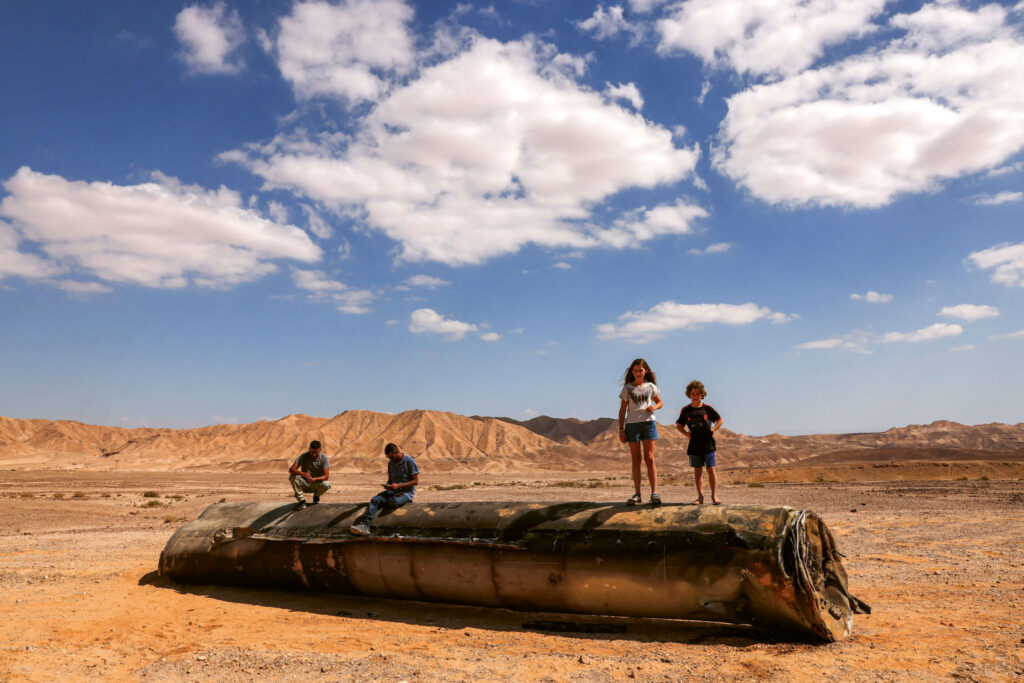
Naturally, the turn towards zero-sum politics is not unique to Israel. Instead, it is the apparent permanence of Israel’s pivot to democratic nationalism that seems unparalleled when set against the vicissitudes of party politics and potential for demographic reverses elsewhere. The radical changes Israel keeps undergoing this century seem, in this light, a harbinger of the shape metapolitical cleavages may soon take elsewhere. These are increasingly contests about who rules—whether unaccountable elites or the larger body politic—and no longer about the minutiae of how.
Yet Israel’s experiment masks complexities beyond its appeal to the nation, the demos, and their deepening fusion. The state’s unstable theological–political formula is often poorly understood, no less among allies than detractors. ‘Religious Zionism’, endlessly chastised, keeps unsettling end-of-history pieties about confining faith and observance to the margins of the public square and smoothing out the nation state’s ethno-religious edges. Yet instead of cool-headed assessments precisely when it holds the keys to governability—and, partly, to draw the war to a close—the rise of this national-religious bloc of parties is often met by incurious moral hysteria.
Shrill accusations of ‘theocracy’ stem from this incuriosity.21 Our hosts dismissed the vacuous trope as veiling a deeper animus against the Jewish nation state—the wedding of a distinct cultural group to a sovereign entity—regardless of its religious basis and commitments. Confusingly, warnings of a slippery slope to divine rule do contrast present-day Israel with an original Jewish state wishfully construed in cultural rather than religious terms: an imaginary entity our hosts claim never existed. For religious nationalists, the Ben-Gurionist Zionism of Israel’s embryonic stage was never straightforwardly secular, any more than the Jewish people’s national yearnings were ever clearly extricable from the Torah’s revelations and strictures. Viewed from this side of liberal-democratic modernity, such contemporary revisions may seem to fling open a perilous and regressive Pandora’s Box. With its strict bisection of the earthly and the spiritual, our Western secularist paradigm is at a loss when the two poles begin to gesture towards reunion. This misunderstanding is most evident in contemporary anti-Zionist discourse, but the sympathies of Israel’s secular, liberal supporters are not spared either. The latter are rendered blind to the post-liberal evolutions of a state onto which they keep projecting an immutable secularist canon, even as challenges to secularism of this kind are most evident in Israel.
Interspersing historical narrative with revelation, this religious-secular ambivalence is neatly captured in the Hebrew Scriptures. Jews engaging with the Torah, we were told, are seen as reading the tale of their ancestors, but are less often viewed as a people taking up once more their sovereign destiny. Beyond the much-touted survival of Jewish peoplehood through the ages, continuities between present-day Israel and the biblical state subdued by Rome in 70 AD are seldom explored. The national-religious discourse of our hosts, however, stressed a historically unbroken thread and argued that the state’s founding in 1948 was nothing but the resurrection of its biblical antecedent. One of our hosts voiced some perplexity at the fact that not all Orthodox Jews in the diaspora had chosen to repatriate yet, in the face of such an evident sign of prophetic fulfilment as Israel’s 73-year endurance. Meanwhile, the construction of the Third Temple was expected to take place sometime within the next 100 years. The Bible’s public status in Israel—as political instruction for self-ruling Jews to fulfil their religious role as a people—sounded an enviable substitute to the human rights discourse that imbibes the West, with its emancipatory individualism and unwavering cult of progress.
With the rescued Gaza hostages on their way home, our own homebound journey was marked by an indescribable contrast. Not merely the indomitable enemy of a barbarous and medieval terror group, the land we took off from seemed a spatial object lying outside our secular and post-national world, an outlier challenging the bounds of time and space. However much Israel pleads with the West to join it, I knew it could only be approached conceptually, from afar. From such a narrow physical terrain stretching towards the eternal, other nations—their earthly form cut off from providence—suddenly appeared contingent and fleeting.
NOTES
1 Nidal Al-Mughrabi, Maayan Lubell, and Ali Sawafta A, ‘Three Israeli Hostages Freed in Gaza, Israel Releases 369 Palestinians in Exchange’, Reuters (15 February 2025), www.reuters.com/world/middle-east/three-israeli-hostages-set-return-gaza-ceasefire-holds-2025-02-15/.
2 Lazar Berman, Emanuel Fabian, and Noam Lehmann, ‘Remains ID’d of Oded Lifshitz, Ariel and Kfir Bibas, but Other Body Is Not the Boys’ Mom Shiri’, The Times of Israel (21 February 2025), www.timesofisrael.com/remains-idd-of-oded-lifshitz-ariel-and-kfir-bibas-but-other-body-isnt-the-boys-mom-shiri/.
3 ‘1,000 Troops Were in Sderot on Oct 7, When They Were Urgently Needed Elsewhere, Probe Finds.’ The Times of Israel (9 April 2025), www.timesofisrael.com/1000-troops-were-in-sderot-on-oct-7-even-as-no-further-terrorists-invaded-city-probe-finds/.
4 Kan 7.10.360, ‘A Digital Memorial Project for the Events of October 7’, www.710360.kan.org.il/en/sderot/minibus, accessed 15 August 2025.
5 Ronn Torossian, ‘Rami Davidian: A Story of Israeli Heroism’, Israel National News (20 February 2024), www.israelnationalnews.com/news/385495.
6 ‘1,000 Troops Were in Sderot on Oct 7, When They Were Urgently Needed Elsewhere, Probe Finds’.
7 ‘Saving Lives and Honoring the Deceased’, ZAKA Search and Rescue, https://zakaworld. org/, accessed 15 August 2025.
8 Sara Lehmann, ‘A Miraculous Escape—The Story of Moshav Tekuma’, Israel National News (21 October 2023), www.israelnationalnews.com/news/378903.
9 ‘The Bnei David Pre-Army IDF Preparatory Yeshiva’, Benidavid.org, www.bneidavid.org/Web/en/default.aspx, accessed 15 August 2025.
10 Mansee Khurana, Adriana Gallardo, and Leila Fadel, ‘An Israeli Raid of a Famous Palestinian Bookstore Stokes Censorship Fears’, NPR (14 February 2025), www.npr.org/2025/02/14/nx-s1-5294328/israel-raid-bookstore-east-jerusalem.
11 Dr Mordechai Kedar, www.mordechaikedar. net/copy-of-%D7%A8%D7%90%D7%A9%D7%99-%D7%A2%D7%91%D7%A8%D7%99%D7%AA?lang=en, accessed 15 August 2025.
12 Thomas L Friedman, ‘Understanding the Middle East Through the Animal Kingdom’, The New York Times (2 February 2024), www.nytimes.com/live/2024/01/30/opinion/thepoint?smid=url-share#friedman-middle-east-animalsm.
13 Bassem Eid, human rights expert, political analyst, commentator, and journalist, www.bassemeid.com/, accessed 15 August 2025.
14 Oren Klass, ‘NGO Seeks to Knock Down Barriers Between Israel’s Christians, Jews’, Israel Hayom (26 December 2021), www.israelhayom.com/2021/12/26/jerusalemite-initiative-bridging-divide-between-israeli-christians-jews/.
15 ‘Shadi Khalloul—An Aramean in Israel’, Christians for Israel International, www.c4israel.org/news/shadi-khalloul-an-aramean-in-israel/, accessed 15 August 2025.
16 ‘Brig. Gen. (res.) Effi Eitam’, The Misgav Institute for National Security and Zionist Strategy, www.misgavins.org/en/brig-gen-effi-eitam-joins/, accessed July 15 2025.
17 Daniel Samet, and Raphael Benlevi, ‘The Pro-America Case for Ending Aid’, Tablet Magazine (6 August 2023), www.tabletmag. com/sections/news/articles/pro-america-case- ending-aid.
18 ‘Simcha Rotman’, The Religious Zionist Party, https://zionutdatit.org.il/en/-/rotman-2/, accessed 20 July 2025.
19 Haaretz English Edition & New York Times (11 July 2016), www.kamaze.co.il/reviews/11480/magazines/ haaretz-english-edition-new-york-times.
20 Yoram Hazony, The Jewish State: The Struggle for Israel’s Soul (Basic Books, 2001).
21 Bernard Avishai, ‘Netanyahu’s Government Takes a Turn Toward Theocracy’, The New Yorker (7 January 2023), www.newyorker.com/news/daily-comment/netanyahus-government-takes-a-turn-toward- theocracy.
Related articles:

